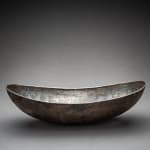Sassanid Silver Elliptical Bowl with Incised Decorations, 5th Century CE - 7th Century CE
Silver
height 24.8 cm
height 9 3/4 in
height 9 3/4 in
X.0367
Further images
The Sassanids were the last native Persian Kingdom to rule Ancient Iran before the Islamic conquest. The Sassanid era was a golden age of Persian culture that witnessed the revival...
The Sassanids were the last native Persian Kingdom to rule Ancient Iran before the Islamic conquest. The Sassanid era was a golden age of Persian culture that witnessed the revival of Zoroastrianism, an ancient mystical belief native to these lands, and a literary Renaissance spurred by the translation of many Old Persian epics written in cuneiform into the Middle Persian language of Pahlavi written in an alphabet derived from Aramaic. Based on written sources and the iconography found in silver dishes such as this one, monumental rock-cut relief sculptures, engraved gems, and coins, scholars have surmised that Sassanian art was an official art, reflecting the ideology of the state, and in particular the state religion: Zoroastrianism.
The storied wealth of the Sassanid court has been confirmed by archaeological excavations that have unearthed shallow bowls forged from precious metals that were likely used to drink wine. Many of the dishes depict portraits of the king on horseback hunting and killing game. The earliest examples of hunting plates date to the 4th Century A.D. These bowls were composed of individually hammered panels of gold, copper, silver that were attached together. The relief of these vessels is sometimes so high, that the figures seem to be inflated. By the 5th Century, however, separate parts were no longer applied; but the entire vessels was cast and subsequently finished with engraved designs. Although religious themes are rarely represented on metal plates, there is an interesting group of works with Zoroastrian motifs and symbols, such as this lovely silver bowl that features an engraved representation of the composite creature known as a Senmurv decorating the center. Typically depicted as a bird with certain mammal characteristics, the Senmurv was said to be the union of earth, sea and sky, according to Persian mythology. The Senmurv is surrounded by a myriad of fish and fowls of all forms and sizes that have all been carefully engraved onto the surface of the silver. These animals all face inwards towards the vertical axis with those below the Senmurv inverted. A fruit-filled foliate band below the rim completes the iconography. Although it may have been used to drink wine from, a silver bowl such as this one was not a mere functional device; judging from the luxury of the material and the intricacy of the engraved designs, this bowl is representative of the elegant sophistication of Sassanian art.
The storied wealth of the Sassanid court has been confirmed by archaeological excavations that have unearthed shallow bowls forged from precious metals that were likely used to drink wine. Many of the dishes depict portraits of the king on horseback hunting and killing game. The earliest examples of hunting plates date to the 4th Century A.D. These bowls were composed of individually hammered panels of gold, copper, silver that were attached together. The relief of these vessels is sometimes so high, that the figures seem to be inflated. By the 5th Century, however, separate parts were no longer applied; but the entire vessels was cast and subsequently finished with engraved designs. Although religious themes are rarely represented on metal plates, there is an interesting group of works with Zoroastrian motifs and symbols, such as this lovely silver bowl that features an engraved representation of the composite creature known as a Senmurv decorating the center. Typically depicted as a bird with certain mammal characteristics, the Senmurv was said to be the union of earth, sea and sky, according to Persian mythology. The Senmurv is surrounded by a myriad of fish and fowls of all forms and sizes that have all been carefully engraved onto the surface of the silver. These animals all face inwards towards the vertical axis with those below the Senmurv inverted. A fruit-filled foliate band below the rim completes the iconography. Although it may have been used to drink wine from, a silver bowl such as this one was not a mere functional device; judging from the luxury of the material and the intricacy of the engraved designs, this bowl is representative of the elegant sophistication of Sassanian art.





